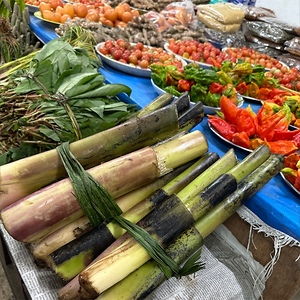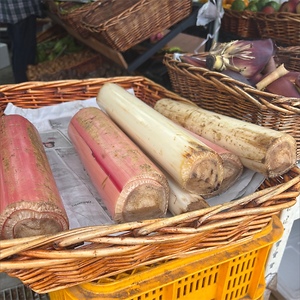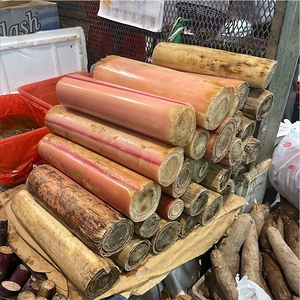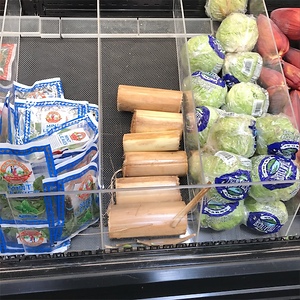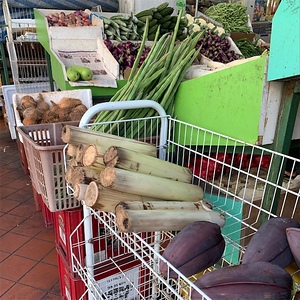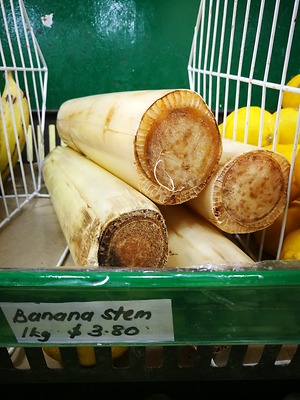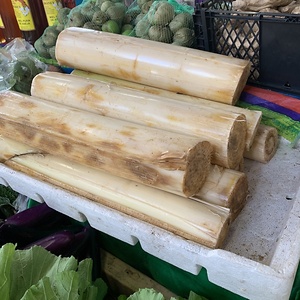

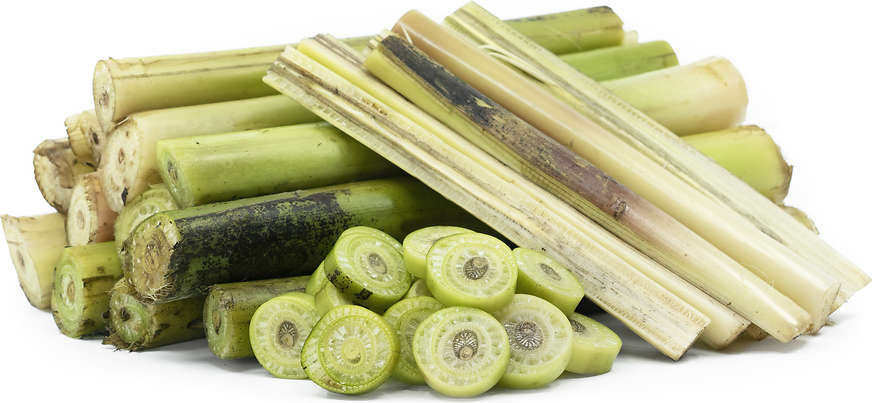
Banana Stem
Estimated Inventory, lb : 0
Description/Taste
Banana stems vary in size, depending on how they are cut from the plant and have a thick, straight, and cylindrical appearance. The elongated stems may appear with their outer husks still intact, showcasing a tough, semi-smooth, and hard sheath. The sheath is inedible, difficult to detach, and appears in variegated shades of green and yellow with red accents. Once removed, porous layers are further stripped away to reveal the inner portion of the stem, sometimes referred to as the core. The white to pale green-yellow core is the edible portion of the stem and is dense and firm with a crisp, starchy consistency. Banana stems have a texture similar to jicama and can be consumed fresh or cooked. The fleshy cores have a mild sweet-tart flavor and a subtly bitter aftertaste.
Seasons/Availability
Banana stems are available year-round in tropical to subtropical climates.
Current Facts
Banana stems, botanically a part of the Musa genus, are found within the upright, central support structure of the banana plant, belonging to the Musaceae family. Despite their name, Banana stems are not true stems but are a type of pseudostem comprised of overlapping leaf sheaths. The edible portion of the stem is the center core, and this core has a mild taste and crisp, succulent consistency. Banana stems are one of the lesser-known edible elements of a banana plant and are used on a small scale in medicinal and culinary preparations. The flowers, fruits, and leaves are also utilized in various culinary uses and are more commonly found in fresh markets. Banana stems are also known as Banana pith, Banana stalk, and several other regional names in their growing areas and are typically foraged from plants grown in plantations, home gardens, and in the wild. Banana stems are favored for their mild bitter-sweet flavor, crisp texture, and nutritional properties.
Nutritional Value
Banana stems are a source of fiber to regulate the digestive tract, potassium to balance fluid levels in the body, and vitamin C to strengthen the immune system. The stems also provide iron to develop the protein hemoglobin for oxygen transport through the bloodstream, magnesium to control optimal nerve functioning, and other nutrients, including vitamin B6, manganese, and copper. In Ayurvedic medicine, Banana stems are juiced and consumed as a beverage to cool and cleanse the body as a natural diuretic.
Applications
Banana stems have mild, vegetal, and sweet-tart flavors suited for fresh and cooked preparations. The freshly harvested stems can be consumed raw if prepared properly, but most consumers choose to cook the stems to develop a softer consistency. Each Banana stem typically has two natural layers, and the outer layer must be discarded before use. Once stripped and prepared, Banana stems should be sliced into small disc-like pieces and cooked into curries with coconut milk or simmered into dals with lentils and spices. In India, Banana stems are also fried into crispy snacks, added to stews, or cooked with spices and aromatics and served over rice. They are also incorporated into vazhaithandu pachadi, a kind of raita served with dal or rice. In Thailand, Banana stems are mixed into soups, curries, and stir-fries. In Burma, the stems are sliced and cooked into mohina, a traditional fish noodle soup. Beyond culinary preparations, Banana stems are combined with buttermilk, lime, and salt and blended into a beverage. Banana stem juice is also a popular refreshing drink and is prepared throughout Southeast Asia. Banana stems readily absorb accompanying flavors and pair well with spices such as turmeric, cumin, mustard seeds, tamarind, and curry leaves, aromatics such as red chiles, garlic, ginger, and onions, lentils, tomatoes, sesame seeds, and grated coconut. Freshly harvested Banana stems should be immediately consumed for the best quality and flavor. The stems will keep for 1 to 2 days when wrapped in plastic and stored in the refrigerator. The stems can also be soaked in buttermilk and stored in the fridge to keep the stems fresh.
Ethnic/Cultural Info
Banana plants are an unusual crop to commercially produce as the stems and leaves die once the plant produces fruit. Despite the initial deterioration of the plant, the underground rhizome eventually produces another stem that sprouts above ground, repeating the plant's life cycle. This process creates large amounts of plant waste on expansive plantations, which is often burned to focus on fruit production. To help reduce waste, Banana stems are being used in alternative processes, such as transforming them into fibers. Banana stem fibers, also known as musa fibers, are a biodegradable material created from processing dried stems into small, fiber-like strands. The strands are left to dry, and after preparation, they can be dyed and woven into various textiles. Banana stems have been used to make clothing, placemats, and rugs for centuries, and some of the first known records of making textile fibers date to the 13th century in the Philippines and Japan. In Japan, bashôfu means "banana-fiber cloth," and the hand-created fibers were extensively used in Okinawa to make specialty clothing, gloves, scarfs, wall hangings, doormats, and tea bags. There are different types of Banana stem fibers, depending on the portion of the stem used, and the inner stem produces the softest fibers. In the 21st century, companies in Uganda have also begun to process Banana stem fibers into wigs. The fibers have a naturally blond coloring, and once softened, the fibers can be dyed to match various hair colors.
Geography/History
Bananas are native to Southeast Asia and have been growing wild since ancient times. Banana plants were an essential crop among early civilizations, and over time, different varieties of bananas were selected from the wild and domesticated into a commercial fruit. Bananas were spread throughout tropical and subtropical regions worldwide through explorers, trade routes, and immigration, and since their global introduction, they have become one of the most cultivated fruits. Despite the banana's popularity, Banana stems are a secondary crop not commercially produced. The stems are primarily sourced and used for culinary purposes in Southeast Asia and are prepared similarly to a vegetable in cooked dishes. Banana stems are used primarily in India, one of the top-producing banana countries in the world. Today Banana stems can be found in local markets in Asia, Southeast Asia, and the South Pacific, and in other regions of the world, they can occasionally be found at specialty Asian and Indian grocery stores.
Recipe Ideas
Recipes that include Banana Stem. One
| Neivedyam |
|
Banana Stem Curry Aratidhoota Koora |
Podcast



